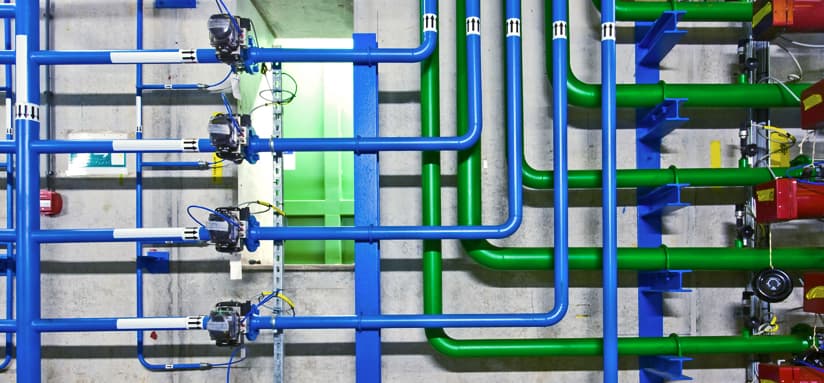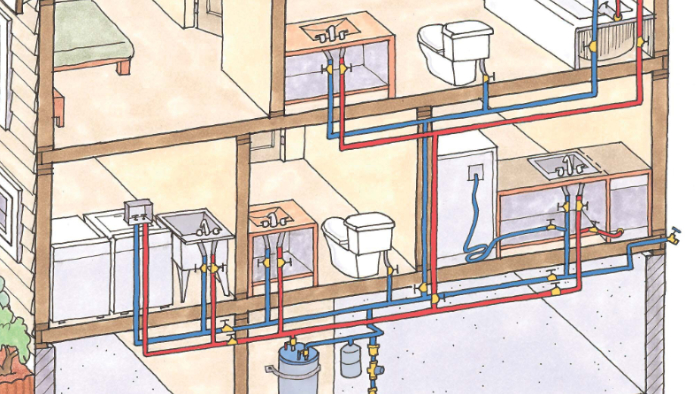We have come across this post relating to Exploring Your Homes Plumbing Anatomy listed below on the internet and figured it made perfect sense to talk about it with you here.

Understanding exactly how your home's pipes system works is vital for every single homeowner. From supplying tidy water for drinking, cooking, and bathing to safely eliminating wastewater, a properly maintained pipes system is crucial for your family members's health and wellness and convenience. In this comprehensive guide, we'll discover the intricate network that makes up your home's plumbing and deal pointers on upkeep, upgrades, and taking care of usual problems.
Intro
Your home's pipes system is greater than simply a network of pipelines; it's an intricate system that ensures you have access to clean water and effective wastewater elimination. Knowing its elements and exactly how they interact can help you protect against costly repair services and ensure whatever runs smoothly.
Fundamental Elements of a Pipes System
Pipes and Tubing
At the heart of your plumbing system are the pipes and tubing that carry water throughout your home. These can be made from different products such as copper, PVC, or PEX, each with its benefits in regards to toughness and cost-effectiveness.
Components: Sinks, Toilets, Showers, etc.
Fixtures like sinks, toilets, showers, and bathtubs are where water is made use of in your home. Understanding just how these fixtures connect to the plumbing system aids in identifying issues and preparing upgrades.
Shutoffs and Shut-off Points
Valves manage the circulation of water in your pipes system. Shut-off shutoffs are essential during emergencies or when you need to make repair work, allowing you to isolate parts of the system without interrupting water circulation to the whole home.
Water Supply System
Key Water Line
The major water line attaches your home to the local supply of water or an exclusive well. It's where water enters your home and is dispersed to different fixtures.
Water Meter and Stress Regulatory Authority
The water meter procedures your water use, while a pressure regulator ensures that water flows at a secure stress throughout your home's pipes system, avoiding damage to pipes and components.
Cold Water vs. Hot Water Lines
Understanding the difference between cold water lines, which provide water straight from the main, and warm water lines, which bring warmed water from the hot water heater, aids in fixing and planning for upgrades.
Drainage System
Drain Pipes Water Lines and Traps
Drain pipes carry wastewater far from sinks, showers, and bathrooms to the drain or septic tank. Catches protect against sewage system gases from entering your home and also catch debris that could cause obstructions.
Air flow Pipes
Air flow pipelines permit air right into the drain system, avoiding suction that could slow down drainage and trigger traps to empty. Correct ventilation is crucial for maintaining the integrity of your plumbing system.
Value of Proper Water Drainage
Guaranteeing proper drainage prevents back-ups and water damage. Routinely cleansing drains and maintaining catches can avoid costly repair services and expand the life of your pipes system.
Water Furnace
Kinds Of Hot Water Heater
Water heaters can be tankless or conventional tank-style. Tankless heating systems heat water as needed, while storage tanks store warmed water for immediate use.
Updating Your Pipes System
Reasons for Updating
Upgrading to water-efficient components or replacing old pipes can enhance water top quality, lower water bills, and enhance the value of your home.
Modern Pipes Technologies and Their Advantages
Explore modern technologies like smart leakage detectors, water-saving commodes, and energy-efficient water heaters that can conserve money and minimize ecological effect.
Expense Factors To Consider and ROI
Compute the ahead of time prices versus long-term savings when considering plumbing upgrades. Lots of upgrades pay for themselves with lowered energy costs and fewer repairs.
Exactly How Water Heaters Attach to the Plumbing System
Understanding just how water heaters link to both the cold water supply and warm water circulation lines assists in identifying concerns like not enough hot water or leakages.
Upkeep Tips for Water Heaters
Regularly purging your hot water heater to remove sediment, checking the temperature settings, and inspecting for leaks can extend its lifespan and improve energy efficiency.
Usual Pipes Concerns
Leakages and Their Reasons
Leakages can happen because of aging pipes, loose fittings, or high water pressure. Dealing with leaks quickly protects against water damages and mold and mildew development.
Blockages and Obstructions
Blockages in drains and toilets are often caused by purging non-flushable items or a buildup of oil and hair. Making use of drainpipe screens and being mindful of what goes down your drains pipes can protect against blockages.
Indications of Plumbing Problems to Expect
Low tide pressure, slow-moving drains pipes, foul odors, or uncommonly high water bills are indicators of prospective plumbing problems that ought to be resolved without delay.
Plumbing Upkeep Tips
Normal Assessments and Checks
Schedule yearly pipes evaluations to catch concerns early. Look for indications of leaks, corrosion, or mineral build-up in faucets and showerheads.
DIY Upkeep Tasks
Basic tasks like cleansing tap aerators, checking for commode leakages using color tablets, or insulating revealed pipes in cool environments can prevent significant plumbing issues.
When to Call an Expert Plumbing
Know when a plumbing problem calls for expert proficiency. Trying complicated repairs without appropriate knowledge can cause more damages and higher repair expenses.
Tips for Minimizing Water Usage
Straightforward routines like dealing with leaks without delay, taking shorter showers, and running complete tons of washing and dishes can preserve water and lower your utility bills.
Eco-Friendly Plumbing Options
Take into consideration sustainable pipes materials like bamboo for floor covering, which is durable and environment-friendly, or recycled glass for countertops.
Emergency Readiness
Steps to Take Throughout a Pipes Emergency
Know where your shut-off shutoffs are located and exactly how to switch off the supply of water in case of a burst pipeline or major leakage.
Importance of Having Emergency Situation Contacts Convenient
Keep call information for neighborhood plumbing technicians or emergency services easily available for quick feedback during a plumbing dilemma.
Environmental Influence and Conservation
Water-Saving Fixtures and Devices
Setting up low-flow taps, showerheads, and bathrooms can substantially lower water use without compromising efficiency.
DIY Emergency Fixes (When Suitable).
Short-lived fixes like using duct tape to patch a dripping pipe or positioning a bucket under a dripping faucet can lessen damages till a professional plumbing technician gets here.
Verdict.
Understanding the makeup of your home's pipes system empowers you to maintain it properly, conserving time and money on repairs. By complying with routine upkeep routines and staying informed about contemporary plumbing innovations, you can guarantee your plumbing system operates effectively for many years to find.
The Anatomy of Your Home s Plumbing System
Understanding the anatomy of your home s plumbing system is essential for any homeowner. It not only helps in identifying potential issues but also facilitates effective communication with professionals when repairs or upgrades are needed. Your home s plumbing system is more than just pipes and faucets; it s a complex network that ensures the efficient and hygienic flow of water in and out of your house. In this blog, we ll dissect the crucial components of your home s plumbing system. For those in Antelope Valley, Brock Plumbing is your trusted partner for all your plumbing needs, ensuring your system functions smoothly and efficiently.
Water Supply System
Main Water Line: This is where your home s plumbing system begins. The main water line connects your home to the public water supply or a private well. Pipes and Shut-off Valves: Pipes distribute water throughout your home. Shut-off valves are crucial for controlling the flow of water and making repairs without shutting off the entire system. Drainage System
Drain Pipes: These pipes carry waste and water away from sinks, toilets, and showers. Vents: Vents allow sewer gases to escape and help maintain proper pressure in the drainage pipes, ensuring efficient flow of wastewater. Traps: Every fixture has a trap, a U-shaped pipe that holds water and prevents sewer gases from entering your home. The most common is the P-trap under sinks. Fixtures and Appliances
Fixtures and appliances are the most interacted with parts of your plumbing system. They include sinks, toilets, showers, dishwashers, and washing machines. Each fixture and appliance has its own supply and drainage connection, ensuring they receive clean water and can dispose of wastewater effectively.
Water Heating System
Your water heater is a crucial component, providing hot water to various fixtures and appliances in your home. It can be tank-based or tankless, with each type having its own set of advantages and maintenance requirements. Regular maintenance is essential to ensure efficient operation and extend the lifespan of the unit.
Sump Pump
In areas prone to flooding or with high water tables, a sump pump is an essential part of the plumbing system. It s installed in the lowest part of your basement or crawlspace and pumps out water that accumulates, preventing flooding and protecting your home from water damage.
Septic System
Homes that are not connected to a municipal sewer system have a septic system and an underground wastewater treatment structure. Understanding how to maintain your septic system is crucial to prevent backups, odors, and early system failure.
Conclusion
Your home s plumbing system is a complex and essential network, ensuring the efficient and hygienic flow of water in and out of your property. Understanding its key components helps in maintaining it properly and identifying issues before they escalate into major problems. For residents in Antelope Valley, Brock Plumbing is dedicated to providing top-notch services, ensuring that every part of your plumbing system is in perfect working order. Trust our team of professionals to handle all your plumbing needs, ensuring your home remains comfortable, safe, and well-maintained.
https://brockplumbinganddrains.com/blog/the-anatomy-of-your-homes-plumbing-system/

As a reader about Understanding Your Home's Plumbing Anatomy, I figured sharing that post was really useful. Those who enjoyed our blog posting plz remember to share it. Thanks so much for your time spent reading it.
Appointment